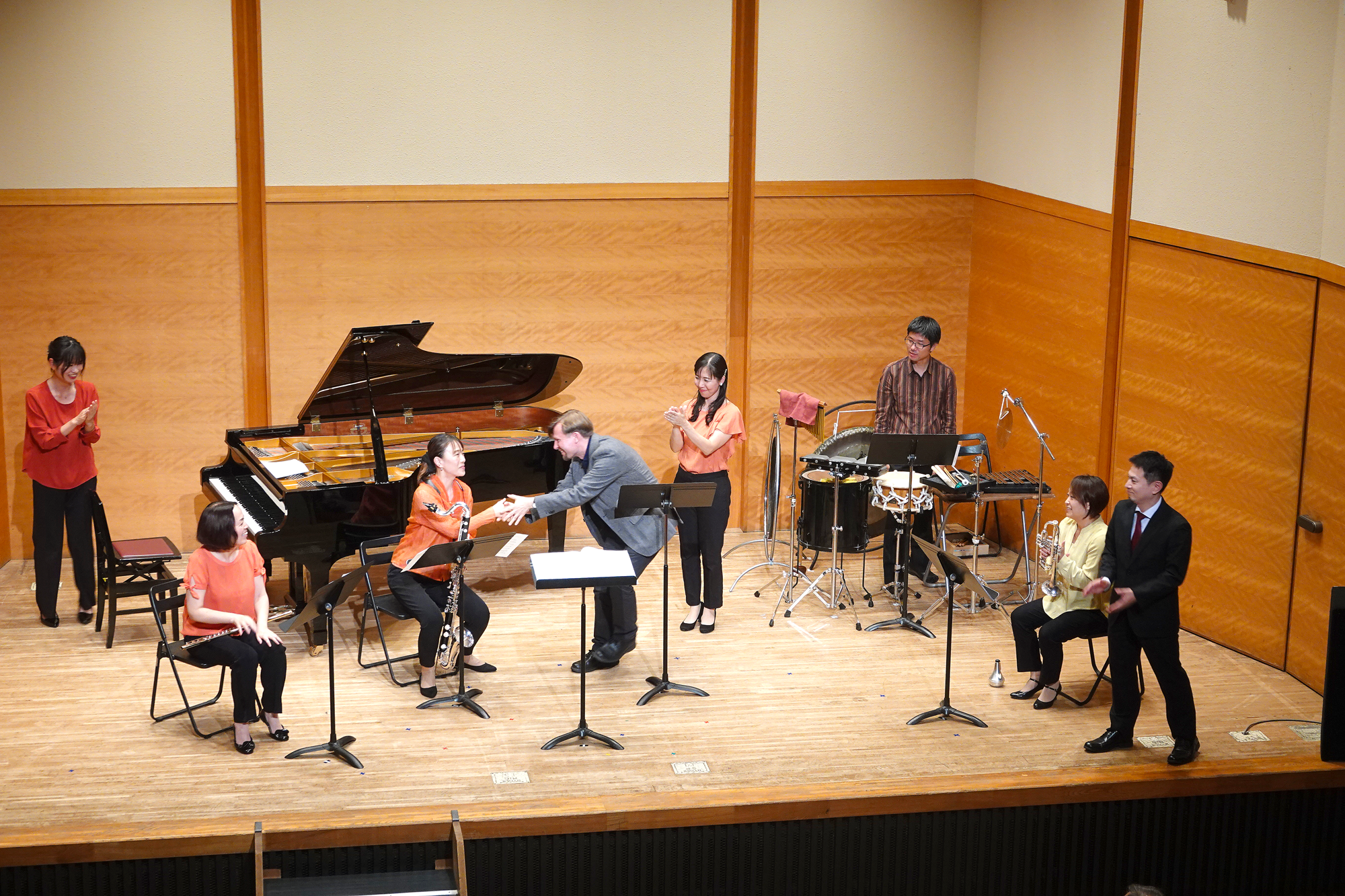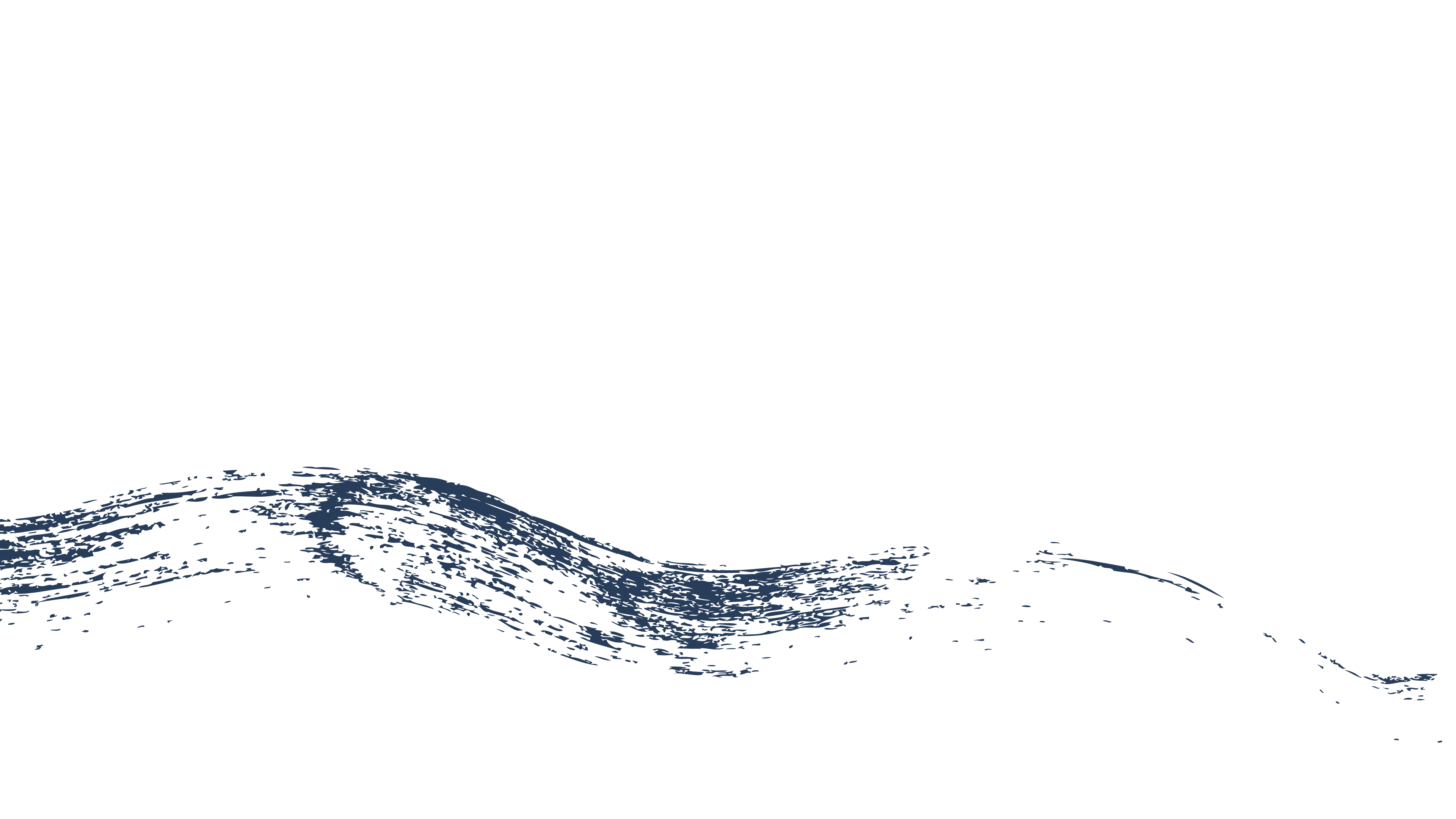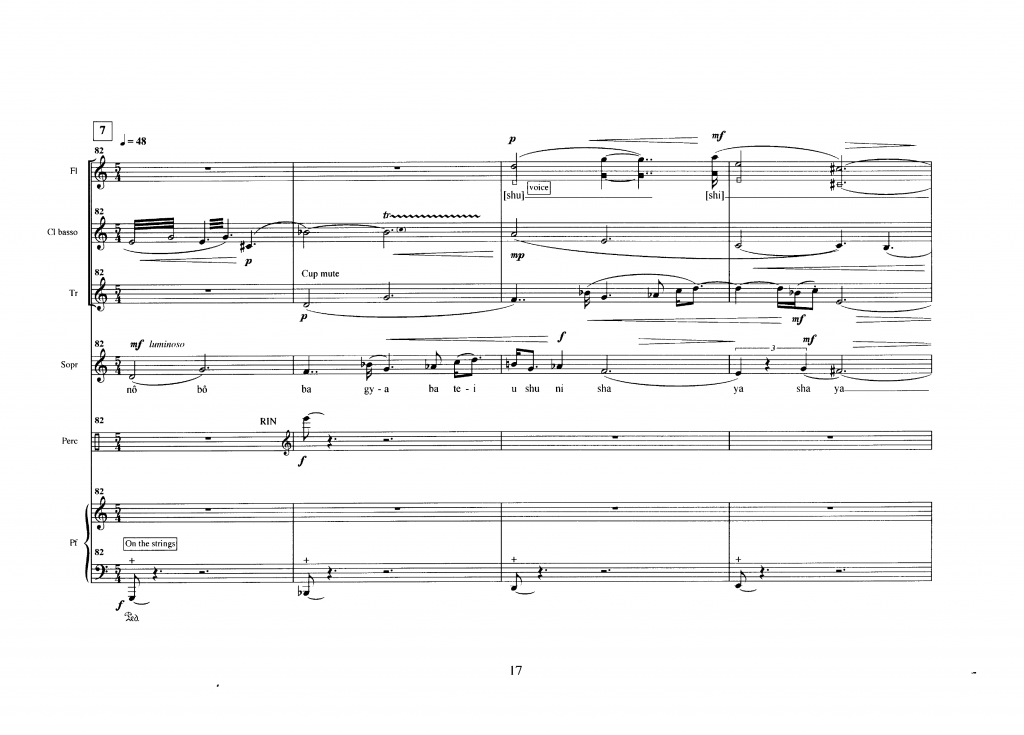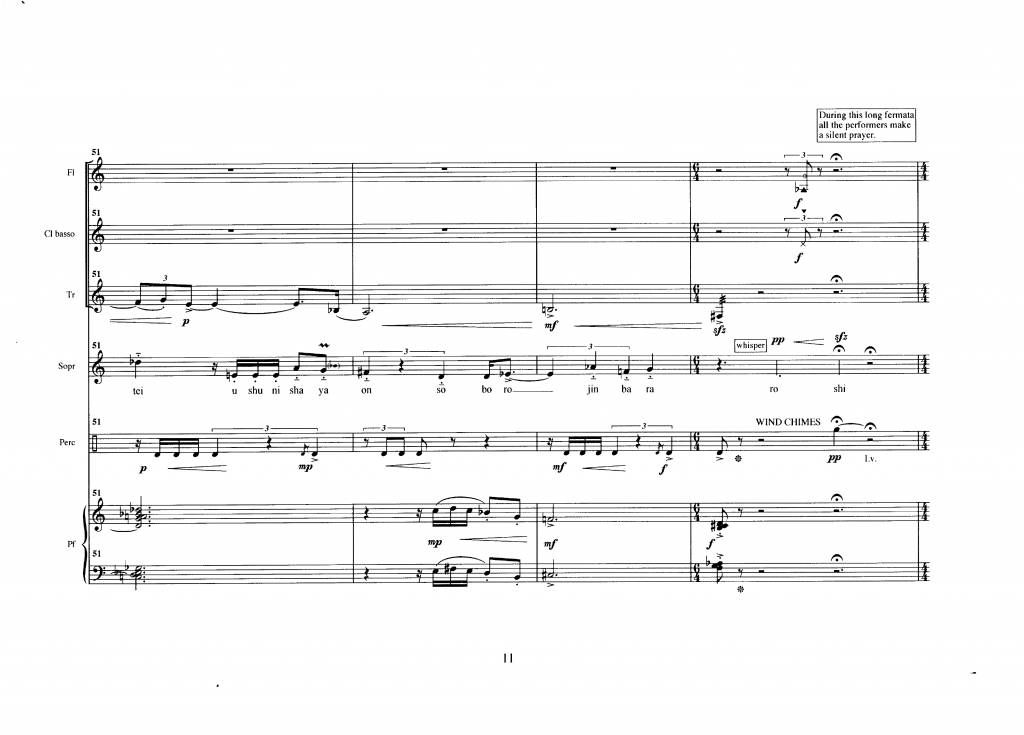TEN (転)—between two worlds
Lasse Lehtonen in interview with the composer Tokunaga Takashi and soprano Akitsu Tomoko (August 2020)

Composer JTKoskinen and musicians of Ensemble H[akka] after the premiere of TEN in Hiroshima (October 27th 2019)
“We live in a world where the basic conditions of our life are in danger. The ecological catastrophe is not any more a dystopia but in parts visible in our everyday reality. As a composer I have to ask myself seriously: after all, what kind of music do we need in such a critical situation?”
Juha T. Koskinen on TEN
Commissioned by Ensemble H[akka], TEN (転), “a turning point,” for soprano and five musicians was premiered in Hiroshima under the baton of composer Tokunaga Takashi (徳永崇) in October 2019. As described by the musicians, practicing and performing the work turned into an artistic journey of exploration that resulted in fascinating cultural realizations—on both sides of the stage.
Ensemble H[akka] occupies an important role in the relatively small but vibrant contemporary music scene in Hiroshima. Tokunaga, who is also the representative of the ensemble, explains that Ensemble H[akka] engages in artistic activities with a mission to promote encounters between people and art.
“Our group performs with a concept that addresses the relationship between art and society, with a focus on contemporary music. As Ensemble H[akka] wishes for new music to be created in Hiroshima and wants to transmit it to the world, we started to commission new works two years ago,” Tokunaga explains.
The commission of TEN was a natural continuation of this process. Tokunaga describes the rehearsals of the work as a process that gradually began to unite the musicians in a unique way.
“At first, many performers struggled with the rhythms and interpretation in the highly original (独自) parts,” Tokunaga reminisces. “There were a lot of sections where I experienced difficulties when reading the score alone. When we started to practice with the ensemble, however, I came to understand the genius of the different instrument combinations. The more we played together, the smaller became the sense of distance between the musicians.”
It is not an exaggeration that this process is deeply integrated into the crystallized musical language of TEN. While Koskinen’s score presents rhythmic values to the minutest detail, the actual performance creates a mesmerizing image of an organic flow that fluctuates freely between rapidly progressing dialogue and almost static tension caused by silence and sustained notes. Yet, this image is as fragile as the world around it: the slightest deviation from the breath-like stream would distort its delicate balance.
In this respect, performing TEN calls for an extensive level of concentration. Tokunaga describes this aspect as a meditative experience.
“Looking at the performers, I noted that upon controlling the tension of the work, the long silent parts greatly impacted the feeling of mental unity among them. I believe that the performers were in a mental state of nothingness (無).”
It is not surprising that Tokunaga would choose to use a term related to Buddhist philosophy when recollecting his experiences. Although TEN is a work of contemporary art music, it is simultaneously a philosophically hybrid exploration of fusing different ways of thought musically. A type of cultural interplay may be observed already in the use of the Buddhalocana mantra and the instrumentation—which includes Japanese instruments, such as the Japanese cup bells (鈴) and the shimedaiko drum (締太鼓)—but even more importantly, this dialogue is deeply integrated to the musical language of TEN.
Akitsu Tomoko (秋津智子), the soprano who premiered the work, believes that especially Koskinen’s interest in and experience of Japanese Buddhist chant, shōmyō (声明), has profoundly influenced the vocal part.
“I recognized much influence from shōmyō. The sound of the instruments, as well, use the timbre of Buddhist ritual implements, producing a religious atmosphere,” Akitsu explains.
Akitsu, who herself works at a Buddhist temple, notes that this type of expression may entail certain difficulties in the performance context of Western art music. For example, ensembles of contemporary music do not usually possess chimes used in Buddhist rituals; in fact, the instruments used in the premiere of TEN had to be collected from various temples in Hiroshima. Similarly, details resembling shōmyō may pose problems for performers trained in Western music.
Yet, in Hiroshima, these difficulties were overcome by an approach inherent to TEN: a dialogue between cultures.
“There were some sections that were difficult to sing in Western vocal technique, so I decided to use a vocal technique of shōmyō in them”, Akitsu explains. “Normally, it is very rare to apply both Western vocal technique and shōmyō vocal techniques in one work. However, there is a very old vocal style called kobushi in Japanese folk songs, and it is very similar to the technique of tying sounds to each other in shōmyō. In TEN, I divided my style of performance by using a folksong-like technique in some parts, shōmyō-like technique in others.”
This may be witnessed in measures 82–86 (4:20–4:48), where Akitsu changes her vocal technique. The change is relatively subtle, yet it manages to create a new atmosphere that irrevocably changes the nature of the music toward the end of the work.
“Using this kind of performance was something very unique to TEN,” Akitsu crystallizes.
According to Tokunaga, Koskinen’s way of using silence as a musical device, as well, was especially fascinating from the viewpoint of a Japanese performer and listener.
“Giving value to silence (沈黙) is extremely important in Japanese culture, but since the members of Ensemble H[akka] usually only perform the Western repertoire, it may be that they were not that familiar with this concept. For that reason, TEN was a good opportunity for us to reconsider our own culture.”
The most apparent moment of silence occurs in the middle of the work—on a fermata in measure 54 (2:34–2:52), during which each musician is instructed to make a silent prayer. Tokunaga notes that as this marks the dramatic turning point in TEN, he wanted to pay careful attention to conveying its significance.
“As I was the one who conducted the work, I understood its concept and structure, so I was able to understand Koskinen’s intention very well. At the dramatic (劇的) change from the boundary between the first and second half, I paid particular attention to the texture of the sound (響).”
What awaits beyond this turning point is open to interpretation. To be sure, the new world to which it carries the listener may be thought of as a musical threshold to a disaster. Considering the history of the city, Hiroshima is certainly not an easy environment for the performance of a work that addresses the possibility of such a calamity.
When asked about the topic, Tokunaga thinks, however, that for the audience, this change did not necessarily denote a disaster.
“As far as I know, the audience did not comment on this aspect. They did, of course, enjoy the performance very much, and the feedback was very positive. I believe that the audience listened to the work more intuitively.”
As interpreted by Tokunaga and Akitsu, the turning point does not ultimately associate with a disaster but, above all, managed to bring cultures and people together in Hiroshima. Tokunaga notes that the presence of the audience was of utmost importance in creating this experience.
“In the second half, the tension becomes liberated by a feeling of floating (浮遊感) in the music, but then the appearance of Akitsu-san’s non-European-style singing creates a unique atmosphere (種異様な空間). While listening to it, I felt like I was watching a Tibetan mandala. I am sure that the audience was able to experience this atmosphere of an unknown dimension (異次元).”
Akitsu observes that this aspect ultimately renders TEN a unique performance that incorporated an element of spiritual solemnity.
“At the very end of the work, it feels as if one is facing salvation—that is, the way leading to the Pure Land (浄土). But at the same time, the last, lingering sound feels unresolved because of the anxiety, or possibly awe, one experiences when facing this unknown world.”


